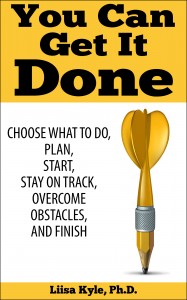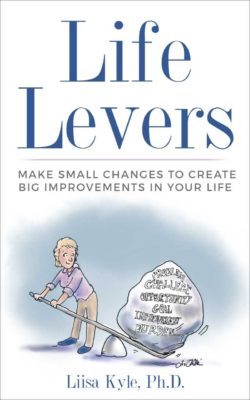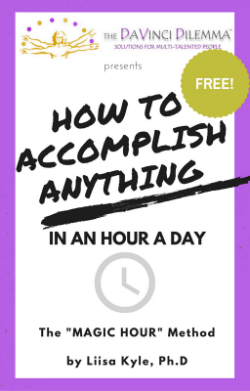
By lylamerle (fridge magnets) [CC BY 2.0 (https://creativecommons.org/licenses/by/2.0)], via Wikimedia Commons
So what’s a DaVinci to do?
We can train ourselves to focus on one thing at a time.
It’s helpful to corral our ideas. Otherwise, we can be at the mercy of random, ever-changing thoughts. We can train ourselves to take charge of our minds in a couple of ways.
First, we can practice controlling our thoughts through meditation. This can be as simple as pausing a few times a day to close your eyes and ‘be’ for three minutes. Clear your mind. Breathe. As thoughts pop up, gently push them aside. When you can reliably take control of your brain during these brief mini-meditations, you are taming your ‘monkey mind’. You are learning how to be the master of your thoughts, rather than at their mercy.
Second, we can use structure to focus our ideas on specific tasks.
One way to apply structure is to prioritize. Rather than doing random things in a random order, be deliberate. What is most important right now? Choose something on which to focus right now.
The next step is to select a period of time for this priority. You could choose to focus on it for fifteen minutes. Or an hour. Or all day. Or all week. The duration will depend on your unique circumstances — just how important is this priority? What else is competing for your attention? What would be a realistic, achievable commitment, given what’s going on in your life? A particular creative project may be our top priority but we can only give it an hour a day. So give it an hour a day. Actually spend an hour a day on it.
Now, consider your second highest priority. How much time can you spend on it? Fifteen minutes a day, three times a week? Great. Do so.
If you are reacting to this approach with skepticism — perhaps you doubt the utility of fifteen minutes commitments, for example –I encourage you to try it. Odds are you can get more done in fifteen minutes than you expect. Certainly, you can get more done in fifteen minutes than if you spend zero time on something. Fifteen minutes, three times a week gives you 45 minutes of progress.
What works best among my coaching clients is to select minimum time commitments that they absolutely, positively know they can accomplish. It’s an achievable promise to themselves that is gratifying to accomplish. If they do more than the minimum, that’s a happy bonus.
As DaVinci’s we have more than one thing going on. The challenge is to find the right combination of priorities and time commitments that work for our personal and professional lives.
Think of these time commitments a ‘time boxes’: precious gifts you give yourself (and your priorities) on a regular basis. Once your top priority ‘time boxes’ are established, you’ll make steady progress on what’s important to you AND you’ll have the have freedom to juggle other projects, tasks, and activities as needed.
For example, my own top priorities these days are writing, making jewelry, working out, and walking my dogs. I’ve worked out a pattern of time boxes so that these things happen regularly throughout the week. (I also commit to fifteen minutes a day of domestic duties because, alas, my household isn’t going to run itself). Once all these time boxes are in place, my schedule still has lots of gaps for professional and personal activities — and the flexibility to do whatever needs doing at a particular time.
It’s the flexibility of this approach that makes it effective for DaVincis. Once you establish your time boxes, you can adjust them to accommodate whatever else is going on in your life.
Let’s say you commit to thirty minutes of practicing guitar every day. Let’s say you have a day job with rigid hours. What will work best for you? Practicing before work, after work, at lunchtime or some combination of the three? Likely you’ll figure out the pattern that works best for you by trial and error.
For example, I know I’m going to write for at least an hour today. I like to write in the morning but I don’t have to. If, say, a client calls with an urgent issue, I can attend to that when it arises, then defer my writing hour to the afternoon.
The other essential step in this approach is to monitor your progress. There’s something intrinsically gratifying about crossing a commitment off your list as ‘done’ or giving your calendar color-coded star for different activities. It acknowledges your progress and motivates you to continue the practice. It reinforces that you are doing more of what you want (and, by extension, less of what you don’t). Bonus points if you reward yourself for your accomplishments.
If you jot down some specifics about what you’ve done , you can save yourself time doing similar things in the future. For example, I keep a log documenting things like the gauge of wire and the diameters of mandrels I use in making particular jewelry pieces. (I can’t tell you how many times I’ve had to look up my notes to fabricate something I was SURE I would remember. Yes, I could figure it out again but it’s much faster and less irksome to simply flip back a few pages and read what I did before).
Perhaps more importantly, when you make a regular practice of monitoring your progress, it makes it clear when things are not getting done. An absence of colored stars on your calendar or a dearth of notes in your documentation logs makes it much harder for things to slide of the rails. Without monitoring, distractions have a way of kidnapping your attention and efforts such that a month later you find yourself asking, “Um, when was the last time I did X?” and/or “Why did I stop?” Instead, ask yourself proactively: how can I easily keep track of my progress on my time boxes? Start monitoring your activities and, should you notice any lapses, take action to correct your course.
If doesn’t matter how much you’ve got going on: you CAN make focused progress on what’s important to you. If you find your thoughts or efforts are scattered, pause and regroup. Focus your thoughts. Prioritize. Figure a way to time box your efforts, given your circumstances. Monitor your progress. Acknowledge your accomplishments and make adjustments as you go.
***
For for tips and techniques to be more productive, check out my book YOU CAN GET IT DONE: Choose What to do, Plan, Start, Stay on Track, Overcome Obstacles, and Finish
***
Want to re-publish this article? Go for it – just include the author’s name, a link to this original post and the following text blurb:
Are you struggling with too many talents, skills, ideas? You may have The DaVinci Dilemma™! Find tools, fun quizzes, coaching, inspiration and solutions for multi-talented people at http://www.davincidilemma.com/ .




